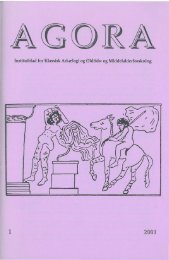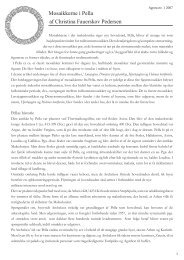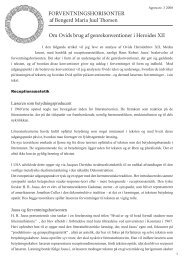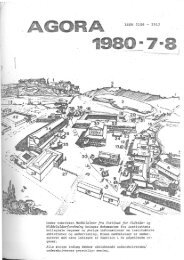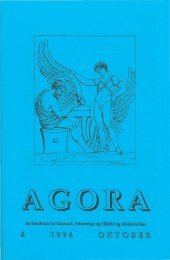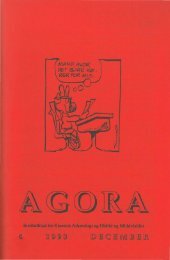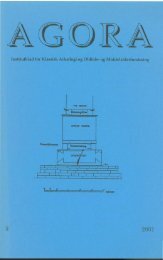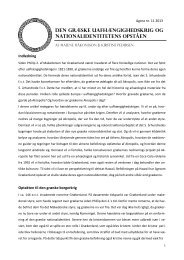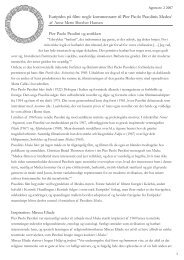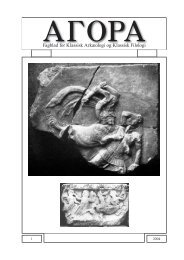Cultural Background - e-agora
Cultural Background - e-agora
Cultural Background - e-agora
You also want an ePaper? Increase the reach of your titles
YUMPU automatically turns print PDFs into web optimized ePapers that Google loves.
<strong>Cultural</strong><br />
<strong>Background</strong><br />
Funerary Patterns in Lebanon—From the<br />
Bronze Age to the Roman Period<br />
By Signe Krag 2<br />
Hellenistic Cities in the Levant<br />
By Eva Mortensen 8<br />
Hellenistic and Roman Sarcophagi in the<br />
Levant<br />
By Philip Ebeling 12<br />
Maron and the Maronites<br />
By Niels Bargfeldt 19<br />
1
During the Bronze Age inhumation burials were the<br />
common practice in Lebanon. The evidence is very<br />
limited, but it suggests that several types of burials<br />
were used at the same time, namely jar burials<br />
(with inhumed infants and small children), rock-cut<br />
tombs, pit graves, cist graves and hypogea with<br />
chambers and possible sarcophagi. The burial gifts<br />
seem to have been placed in the graves according<br />
to the sex of the deceased, as men are often buried<br />
with weapons and women are buried with domes-<br />
tic objects and jewellery. Furthermore, luxury items<br />
are placed in some of the graves, a fact which sug-<br />
gests the existence of a society with marked social<br />
differences. At Sidon we find evidence for the prac-<br />
tice of animal sacrifice, and ovens that are placed at<br />
the graves suggest a belief in the afterlife of the<br />
Agora nr. 8 2011<br />
Funerary Patterns in Lebanon—From<br />
the Bronze Age to the Roman Period<br />
By Signe Krag<br />
deceased. On the sarcophagus of Ahiram from Byblos are depictions of mourning women which could tell<br />
us how the deceased was mourned. The evidence comes mainly from Beirut, Sidon and Byblos.<br />
During the Iron Age both inhumation and cremation burials were in use. The burial types from the<br />
Bronze Age were largely still employed in this period, but new types also occured and these were cist and<br />
chamber tombs, shaft graves and cremations in amphorae. At the same time, the well-known pit grave<br />
became more complex. Again the burial gifts often seem to be placed in the graves according to the sex of<br />
the deceased, and stelae are sometimes found marking the graves. The amount of gifts increases in this<br />
period and luxury items are placed in some of the graves. In Achziv the chamber tombs have a hole cut in<br />
the ceiling, which indicates liquid offerings and an emphasis on the afterlife of the deceased. The crema-<br />
tion graves, which appear for the first time during the Iron Age, consist of urns deposited directly into an<br />
area of coastal sand, and at Tambourit they were deposited in a cave. The burning of incense is attested<br />
and the pottery suggests an emphasis on libations. Also talismen and magical items appear such as terra-<br />
cotta masks and figurines. The evidence comes mainly from Achziv, Khalde, Tyre and Tambourit.<br />
Photo: Signe Krag<br />
Fig. 1: The sarcophagus of Ahiram depicting mourning women.<br />
2
Photo: Signe Krag<br />
Funerary Patterns in Lebanon<br />
By Signe Krag<br />
Agora nr. 8 2011<br />
During the Bronze Age as well as the Iron Age there was a strong influence from Egypt especially seen in<br />
the sarcophagi and burial gifts from Byblos. In general the Phoenicians always placed their deceased far<br />
away from their settlements. One settlement could often have more than one cemetery, but in each of<br />
them both inhumation and cremation could be used at the same time and even in the same grave. Most<br />
of the burials were individual, but several dead could sometimes be placed in the same burial vaults or<br />
chambers. The multiple burials suggest an emphasis on groups, whereas single burials suggest an empha-<br />
sis on individuals.<br />
Photo: Signe Krag<br />
Fig. 2: A sarcophagus in a chamber of a hypogeum in Byblos. Fig. 3: A stelae from Tyre depicting a human<br />
face.<br />
During the Persian period many of the earlier burial types from the Bronze Age and Iron Age contin-<br />
ued to be in use, but a strong influence from Greece was also present. The sarcophagi were largely im-<br />
ported from Egypt, Greece and Asia Minor. These were anthropoid sarcophagi, which were a mixture of<br />
Greek and Egyptian style, and sarchophagi with reliefs. From the archaeological evidence we know that<br />
color was applied to some of these sarcophagi. These would have been placed in hypogea or shaft graves.<br />
Again, the burial gifts seem to be placed in graves according to the sex of the deceased, and luxury items<br />
are only placed in some of the graves. Also the sarcophagi must have been available to only some people<br />
in the society. On the sarcophagus of weepers from Sidon we see mourning women, and the depiction<br />
could tell us how the deceased was mourned. At the sarcophagus of Tabnit from Sidon an inscription tells<br />
about the food and libation offerings to the dead, which suggest an emphasis on the afterlife of the de-<br />
ceased. There have been found traces after the practice of mummification, which show a strong connec-<br />
3
Funerary Patterns in Lebanon<br />
By Signe Krag<br />
Agora nr. 8 2011<br />
tion to Egypt. The burning of incense is attested, and the pottery suggests an emphasis on libations. Also<br />
talismen and magical items appear. The evidence comes mainly from Sidon, Ram Az-Zahab, Sarepta and<br />
Amrit.<br />
The evidence from the Hellenistic period is very limited. The types of burials in use were single pit<br />
graves, cist graves, shaft graves, communal, rock-cut chamber tombs with possible loculi, sarcophagi with<br />
decoration in painted relief and tower tombs. The reuse of graves became very frequent in this period, as<br />
fewer resources were used on the construction of graves and decoration. The burial gifts often seem to be<br />
placed in the graves according to the sex of the deceased and stelae are found marking the graves. The<br />
amount of burial gifts decreases in this period, luxury items are not very common and the sarcophagi<br />
must only have been available to few in the society. Talismen appear, and the pottery suggests an empha-<br />
sis on libations. The evidence comes mainly from Beirut, Sidon and Hermel.<br />
When the Roman culture began to influence the burial rites of Lebanon it had several results. There<br />
was the direct influence of Roman culture, the mixture of Roman and indigenous cultures, the continua-<br />
tion of older traditions and the influence by non-Romen foreigners. The types of burials in use were<br />
Photo: Signe Krag<br />
Fig. 4: A funerary enclosure at Tyre with loculi and a sarcophagus placed at the second floor.<br />
4
Funerary Patterns in Lebanon<br />
By Signe Krag<br />
Agora nr. 8 2011<br />
vaulted chambers with side loculi or burial pits, large burial cambers with decorated plastered walls, caves<br />
in the bedrock with chambers – possibly with coffins –, rectangular tomb buildings, funerary enclosures<br />
with loculus graves and possibly sarcophagi, freestanding sarcophagi, pit graves and also extensive reuse.<br />
Inhumation was mainly used through this period. Multiple burials now became more widespread, possibly<br />
because of Roman influence. Like the burial types the burial gifts were inspired from different areas and<br />
could be coins, glass and masks made to resemble faces. There is also a frequent appearance of talismen<br />
such as figurines, coins placed in the mouth of the deceased and other magical items. The burial gifts of-<br />
ten seem to be placed in the graves according to the sex of the deceased, and the pottery suggests an em-<br />
phasis on libations. Monumentalized necropoleis were located outside the citywalls along the main thor-<br />
oughfares. The change in urban development affected the layout of the necropoleis and the construction<br />
of the graves as well. Overall there was a strong continuation of the older, indigenous culture with some<br />
Roman influences that varied in each area of Lebanon. The evidence comes mainly from Sidon, Beirut and<br />
Tyre.<br />
Fig. 5: Greek sarcophagi placed along the main throughfare at Tyre.<br />
Photo: Signe Krag<br />
5
Funerary Patterns in Lebanon<br />
By Signe Krag<br />
Agora nr. 8 2011<br />
From the Hellenistic to the Roman period the influence from outside Lebanon became very strong. The<br />
influence came from Asia Minor, Greece, Rome, Mesopotamia, Syria and many other areas. The Phoeni-<br />
cians exercised extensive seatrade so already in the early periods Lebanon was influenced by different<br />
cultures. During the Persian and Hellenistic periods the Greek culture came to Lebanon. During the Roman<br />
period Lebanon became a part of the Roman province of Syria and was subject to Roman influence as well<br />
as influence from other parts of the province.<br />
Further Reading<br />
Aubet, E. A. 2001. The Phoenicians and the West: Politics, Colonies, and Trade. Cambridge.<br />
Aubet, M. E. 2004. The Phoenician Cemetery of Tyre-Al Bass: Excavations 1997-1999. BAAL Hors-Série 1.<br />
Beirut.<br />
Contenau, G. 1920. “Mission archéologique à Sidon (1914), pp. 16-55, in Syria, 1.<br />
Doumet-Serhal, C. 2010. “Sidon during the Bronze Age: Burials, Rituals and Feasting Grounds at the<br />
“College Site”, p. 114-129, in Near Eastern Archaeology 73, no. 2.<br />
Elayi, J., & Hayhal, M. R. 1996. Nouvelles découvertes sur les usages funéraires des Phéniciens d’Arwad.<br />
Paris.<br />
Fleischer, R. 1983. Der Klagefrauensarkophag aus Sidon. Tübingen.<br />
Gras, M, Rouillard, P & Teixidor, J. 1991. “The Phoenicians and Death”, pp. 127-176, in Berytus.<br />
Hachmann, R. 1967. “Das Königsgrab V von Jebeil (Byblos)”, pp. 93-114, in Istanbuler Mitteilungen.<br />
Hamdy Bey, O. 1892. Une Nécropole Royale a Sidon: Fouilles de Hamdy Bey: Texte I, II,1- II,2. Paris.<br />
Ilan, D. 2002. „Mortuary Practices in the Early Bronze Age Canaan“, pp. 92-104, in Near Eastern Archaeology<br />
65, no. 2.<br />
Jidejian, N. 1971a. Sidon Through the Ages. Beirut.<br />
Jidejian, N. 1971b. Byblos Through the Ages. Beirut.<br />
Jong, L. D. 2001. „Aspects of Roman Burialpractices in Beirut: On Romanization and <strong>Cultural</strong> Exchange“, p.<br />
293-312, in ARAM periodical 13.<br />
Jong, L. D. 2010. “Performing Death in Tyre: The Life and Afterlife of a Roman Cemetery in the Province of<br />
Syria”, pp. 597-630, in American Journal of Archaeology 114.<br />
Kleemann, I. 1958. Der Satrapen-Sarkophag aus Sidon. Berlin.<br />
Lembke, K. 2001. Phönizische anthropoide Sarkophage. Mainz.<br />
6
Markoe, G. 2000. The Phoenicians. Berkeley.<br />
Funerary Patterns in Lebanon<br />
By Signe Krag<br />
Agora nr. 8 2011<br />
Mazar, E. 2001. “The Phoenicians in Achziv. The southern cemetery. Final report of the excavations 1988-<br />
1990, in Cuadernos de Arqueologia Mediterránea, no. 7.<br />
Montet, P. 1928. Byblos et l’Egypte: Quatre campagnes de fouilles à Gebeil, 1921 – 1922 – 1923 – 1924,<br />
Texte. Paris.<br />
Montet, P. 1929. Byblos et l’Egypte: Quatre campagnes de fouilles à Gebeil, 1921 – 1922 – 1923 – 1924,<br />
Atlas. Paris.<br />
Perdrizet, P. 1938. “Le Monument De Hermel”, pp. 47-71, in Syria, vol. 19, no. 1.<br />
Porada, E. 1973. “Notes on the Sarcophagus of Ahiram”, pp. 355-372, in Journal of the Ancient Near-<br />
Eastern Society of Columbia University 5.<br />
Prausnitz, W. 1982. “Die Nekropolen von Akhziv und die Entwicklung der Keramik vom 10, bis zum 7. Jahrhundert<br />
v. Chr. In Akhziv, Samaria und Ashdod“, pp. 31-44, in Niemeyer, H. G (ed.), Die Phönizier im Westen.<br />
Mainz.<br />
Sader, H. 1995. „Nécropoles et Tombes Phéniciennes du Liban”, pp. 15-30, in Cuadernos de Arqueologia<br />
Mediterránea, no. 1.<br />
Saidah, R. 1969. „Archaeology in the Lebanon 1968-1969“, pp. 119-142, in Berytus 18.<br />
Saidah, R. 1966. „Fouilles de Khaldé“, pp. 51-90, in Bulleuin du Musée de Beyrouth 19.<br />
Saidah, R. 1970. ”Une tombe de l’Age du Fer à Tambourit (région de Sidon)”, pp. 135-146, in Berytus, vol.<br />
25.<br />
Saidah, R. 1993-1994. “Beirut in the Bronze Age: The Kharji Tombs”, pp. 137-210, in Berytus.<br />
Salles, J. F. 1994. “La mort à Byblos: les nécropoles, pp. 49-71, in (red.) Acqurao, E., & Mazza, F, Biblo. Una<br />
città e la sua cultura. Roma.<br />
Schmidt-Dounas, B. 1985. Der lykische Sarkophag aus Sidon. Tübingen.<br />
Smidt, P., Horwitz, L., & Zias, J. 1990. ”Human remains from the Iron Age cemeteries at Akhziv”, pp. 137-<br />
150, in Rivista di Studi Fenici XVIII.<br />
Stuart, B. 2001.“Cemeteries in Beirut”, pp. 87-112, in ARAM Periodical 13.<br />
Torrey, C. C. 1919. “A Phoenician Necropolis at Sidon”, pp. 1-27, in The Annual of the American School of<br />
Oriental Research in Jerusalem, vol. 1.<br />
Toynbee, J. M. C. 1971. Death and Burial in the Roman World. London.<br />
Will, E. 1951. “Monuments funéraries syriens endehors de la Syrie”, pp. 352-356, in Syria.<br />
Winter, F. 1912. Der Alexandersarkophag aus Sidon. Strassburg.<br />
Wolff, S. R. 2002. “Mortuary Practices in the Persian Period of the Levant”, pp. 131-137, in Near Eastern<br />
Archaeology, vol. 65, no. 2.<br />
7
Hellenistic Cities in the Levant<br />
By Eva Mortensen<br />
Agora nr. 8 2011<br />
The Hellenistic period in the Levant was a time, where the power balance shifted back and forth between<br />
foreign empires and local rulers. After Alexander’s death the diadochoi fought over the area for different<br />
reasons. The Ptolemies in Egypt considered it a defence line preventing invasions from the north, while<br />
those diadochoi aspiring to take over all of Alexander’s empire saw Syria as the connecting link between<br />
the Mediterranean and Mesopotamia/Central Asia. In the ca 300 years, that passed, until the Romans<br />
took over, the area was primarily under alternating Ptolemaic and Seleucid control. Besides these he-<br />
gemonies smaller powers gained footing, among others the Hasmoneans and the Nabataeans (timeline).<br />
The struggle for power between these different kingdoms and empires of course had its impact on<br />
the cities. The settling Macedonians and Greeks also had a say in the changes that took place in the cities<br />
during the Hellenistic period. These changes, which the old Phoenician cities and other indigenous cities as<br />
well as the new- and re-founded cities were exposed to, originated to a large extent in the Greek polis<br />
model. The changes could for example involve an orthogonal lay-out of the city with buildings such as<br />
gymnasiums and stadiums as well as the introduction of Greek institutions as boule and demos and their<br />
associated buildings. Generally, though, it seems that the public buildings of the cities were modest in<br />
comparison with their later monumental Roman counterparts.<br />
The cities of course responded differently to this transformation. Some cities, as the old Phoenician<br />
cities, adopted parts of the Greek culture (e.g. the coin tradition, Greek art) while maintaining aspects of<br />
their own culture (e.g. keeping their old city names, using Phoenician along with Greek in inscriptions and<br />
on coins). The Seleucid city foundations, especially in the north, adopted the Hellenistic orthogonal street<br />
grid and carried it to the Roman period. These “Hellenisation” trends were not welcomed everywhere,<br />
and in Jerusalem they caused a revolt and thereby a change in the power relations in southern Syria.<br />
By far the most of what we know about the cities in this period comes from the written sources –<br />
often combined with numismatic evidence – whereas archaeological discoveries of the Hellenistic layers<br />
of the cities are scarce. This fact has primarily to do with the overlying Roman and Byzantine remains.<br />
From ancient writers and epigraphy we may learn about the physical appearance of a city, while numis-<br />
matic on the other hand gives us valuable information about the political affiliations of the cities through<br />
the troubled period.<br />
8
Beirut<br />
Hellenistic cities in the Levant<br />
By Eva Mortensen<br />
Agora nr. 8 2011<br />
As far as the Hellenistic architectural remains are concerned, excavations in Beirut have shown some in-<br />
teresting results in the recent decades. In pre-Hellenistic times the Phoenician city grew around the cita-<br />
del and was confined to the area around the harbour. Beirut was a dependency of Sidon with a client dy-<br />
nast ruling on Persia’s behalf. In the early to mid 4 th century BC the city saw a big phase of urban expan-<br />
sion – the street grid was orthogonal; that is a planned grid not respecting the topography of the Late<br />
Bronze Age. Therefore it might be that Beirut was a site for a Sidonian colony, a re-foundation. Unfortu-<br />
nately this is not attested in any of the written sources, so this can be no more than an educated guess. In<br />
the early 3 rd century BC the city gained independency from Sidon, and there is only a minimum of building<br />
activity. We have remains of two semicircular towers, which were a part of the Hellenistic fortifications.<br />
One tower was added to the corner of the citadel (fig. 1), while the other tower was in the south-eastern<br />
corner of the occupied area (fig. 2). They might have been built at the time of the independency, or they<br />
might have been from the next phase of urbanisation, namely around 200 BC, when the city started grow-<br />
ing again. This was part of the Seleucid urbanisation policy and for a while in the 2 nd century BC the city<br />
was named Laodicea.<br />
Photo: Eva Mortensen<br />
Fig. 1: The northernmost Hellenistic tower. Today it can be seen from Waygand street, where it is<br />
bridged over George Haddad street.<br />
9
Regarding the archaeological remains from<br />
this period we have some from the souk. The<br />
souk is the area on the western side of the<br />
citadel. It has now been built over by a shop-<br />
ping centre, but remains of the Hellenistic<br />
houses are still visible and open to the public.<br />
Before the end of the 6 th century BC this area<br />
was open land. In the first phase of building<br />
activity between 600 and 350 BC only the<br />
eastern part was occupied by buildings, but<br />
with the Seleucid expansion of the city the<br />
built-up area spread to the western part of<br />
the souk, again according to a grid lay-out.<br />
The excavations have shown that the area<br />
was a domestic and a shop- and workshop-<br />
area (fig. 3). The streets and the buildings of<br />
the souk were in use from the Hellenistic pe-<br />
riod and all the way through Roman and Byz-<br />
antine times until the earthquake in 551 AD.<br />
As for remains of Hellenistic public<br />
buildings we are rather shorthanded. From<br />
the epigraphy we know that Hellenistic Bei-<br />
rut had an <strong>agora</strong> and a temple to Astarte.<br />
Neither has been identified, but it seems pos-<br />
sible that the later Roman forum was placed<br />
on the same spot as the old <strong>agora</strong>. One thing<br />
that the excavations have shown, though, is<br />
Hellenistic cities in the Levant<br />
By Eva Mortensen<br />
Agora nr. 8 2011<br />
that Hellenistic Beirut lacked monumental public spaces and buildings before the 1 st century BC. Here, as<br />
we know from Josephus (BJ 1.422), the city received halls, colonnades, temples and market-places from<br />
Herod the Great, who was generous to cities outside of his realm. This continued into Roman times,<br />
where the city was further embellished by other Herodian dynasts.<br />
Photo: Eva Mortensen<br />
Fig. 2: The southernmost Hellenistic tower. Today it can be seen in the<br />
courtyard of the café Paul on George Haddad street near the intersection<br />
with Gouraud street.<br />
Photo: Eva Mortensen<br />
Fig. 3: Remains of Hellenistic houses, shops and workshops, as preserved<br />
under the modern mall.<br />
10
Hellenistic cities in the Levant<br />
By Eva Mortensen<br />
Agora nr. 8 2011<br />
Strabo (16.2.19) tells us that the city was destroyed because of the Seleucid civil wars and that it<br />
was first restored when it became a Roman colony. This fits well with the hiatus in archaeological remains<br />
in the period from the middle of the 2 nd century to the middle of the 1 st century BC. On the other hand,<br />
coins tell us a different story – because the city starts minting already in the 120’s, which must mean that<br />
the city was back on its feet.<br />
Further Reading<br />
Ball, W. 2000. Rome in the East. The Transformation of an Empire, London/New York.<br />
Browning, I. 1982. Jerash and the Decapolis, London.<br />
Butcher, K. 2003. Roman Syria and the Near East, London.<br />
Cohen, G. M. 2006. The Hellenistic Settlements in Syria, the Red Sea Basin and North Africa, Berkeley/Los<br />
Angeles/London.<br />
Grainger, J. D. 1991. Hellenistic Phoenicia, Oxford.<br />
Millar, F. 1983. “The Phoenician cities: A case-study of Hellenisation”. PCPS 209: 55-71.<br />
Perring, D. 2003. “The archaeology of Beirut. A report on work in the insula of the house of the fountains”.<br />
AntJ 83: 195-229.<br />
Perring, D. 2001-02. “Beirut in Antiquity: Some research directions suggested by recent excavations in the<br />
souks”. ARAM 13-14: 129-140.<br />
Satre, M. 2007. The Middle East under Rome, Cambridge/London.<br />
Satre, M. 2001. D’Alexandre à Zenobie. Histoire du Levant antique. IV e siècle av. J.-C. – III e siècle ap. J.-C.,<br />
Paris.<br />
Tscherikower, V. 1927. Die Hellenistischen Städtegründungen von Alexander dem Grossen bis auf die Römerzeit<br />
(Philologus, suppl. XIX.1), Leipzig: 64-69.<br />
A selection of written sources: App. Syr. 52-70; Joseph AJ XII; Polyb. V.40-87; Strabo XVI.2; I & II Maccabees.<br />
11
Hellenistic cities in the Levant<br />
By Eva Mortensen<br />
Agora nr. 8 2011<br />
12
Hellenistic cities in the Levant<br />
By Eva Mortensen<br />
Agora nr. 8 2011<br />
13
Introduction<br />
Agora nr. 8 2011<br />
Hellenistic and Roman Sarcophagi in<br />
the Levant<br />
By Philip Ebeling<br />
„Sarcophagus“ is a word Plinius used for a special kind of stone (lapis) from Assos (southern Troad/Asia<br />
Minor) and means „flesh eating“ from the Greek σαρκοφαγός. It is said about this stone that it eats bodies<br />
in 40 days and it doesn't leave anything but the teeth (Plinius, Naturalis Historia, 36. 27).<br />
The change in sepulchral culture from cremation burial to inhumation (under the Caesars Trajan and Ha-<br />
drian, around AD 120) people started using sarcophagi for burials. That caused a sarcophagus production<br />
in the Roman Empire. The highest production of Hellenistic/Roman sarcophagi seems to have been about<br />
AD 150 – AD 250 in the Roman imperial times. But there have been sarcophagi before: in Greece, Asia Mi-<br />
nor, Etruria, Phoenicia, and of cause in Egypt, where their development probably started. When they<br />
came to ancient Rome, their shapes and usage had already changed, and the artisans of Rome, Athens,<br />
and Asia Minor crafted numerous new shapes and decorations.<br />
Basics<br />
Introduction to Sarcophagi<br />
Materials for sarcophagi were wood, clay, terracotta, stone and lead. Every sarcophagus consists of two<br />
pieces: the box and the lid. There were three big centres of sarcophagus production in roman times:<br />
Rome, Athens, and Asia Minor (especially Dokimeion in Phrygia, which exported the most and had the<br />
highest influence on the other sarcophagus production sites in Anatolia). Each centre used different<br />
shapes, styles and motives. So there are three types of sarcophagi that can be distinguished easily: Mu-<br />
nicipal Roman, Attic and Asia Minorian. The placements of sarcophagi were different: inside of buildings<br />
or outside on cemeteries. The dimensions of sarcophagi are defined by their purpose (→ small person =<br />
small sarcophagus).<br />
Sarcophagi in the Levant<br />
Introduction to the Sarcophagi Found in the Levant<br />
Sarcophagi have a long history in the Levant and the earliest Hellenistic/Roman sarcophagus found in the<br />
Levant is dated to the middle of the 5 th century BC (the “Satrap Sarcophagus”), the latest is perhaps from<br />
the 4 th century AD. But a lot of Roman sarcophagi were still re-used in the Crusader Period.<br />
14
Agora nr. 8 2011<br />
Hellenistic and Roman Sarcophagi in<br />
the Levant By Philip Ebeling<br />
Most of the 300 remaining sarcophagi (as of 1977) were made between AD 150 and 250. Around<br />
half of them were imported from Attica, Rome, or Asia Minor, the other half were made locally. These are<br />
easily distinguished: marble sarcophagi are imported, because there is no marble in the Levant (this in-<br />
cludes the sarcophagi from Assos as well. They are not marble, but they were exported, i.e. to the Levant).<br />
Limestone sarcophagi have produced locally. But there is a third group: the semi-finished goods (fig. 1).<br />
These sarcophagi were half-done in the quarries, exported and finished at their destination, where they<br />
could be fully carved by the local craftsmen to fulfil the clients’ desires. But the majority of those semi-<br />
finished sarcophagi were not finished and just used as they came, which resulted in a lot of limestone cop-<br />
ies being made of semi-finished marble ones.<br />
Fig. 1: Four semi-finished sarcophagi in situ at the cemetery, excavated in 1964/65. The second sarcophagus from the left is one<br />
of four Assos-Stone sarcophagi on this cemetery. The other three are in Proconnesian marble.<br />
This fact led to the discussion if it is still appropriate to call them semi-finished. There are many possible<br />
reasons why they have not been carved out as elaborately as the Municipal Roman, Attic or Asia Minorian<br />
examples: the tradition to bury a corpse as soon as possible, poverty, or just the simple option that the<br />
masses liked the quarry-state shapes. In the end, there is not enough archaeological or textual evidence to<br />
prove either one of those options.<br />
Photo: Niels Bargfeldt<br />
The first imported, finished sarcophagi date to around AD 150, were mainly used in the coastal<br />
towns, and most of them were Attic. Soon after AD 150, import of Dokimeion sarcophagi starts, but there<br />
are just two examples from the 3 rd century. When the sarcophagus production ends in Athens and Doki-<br />
meion (around AD 300), a small group of Municipal Roman sarcophagi can be seen in the Levant. Im-<br />
15
Agora nr. 8 2011<br />
Hellenistic and Roman Sarcophagi in<br />
the Levant By Philip Ebeling<br />
ported sarcophagi were frequently copied by local craftsmen. Attic specialties are imitated often, but the<br />
local garland-sarcophagi are mainly influenced by Asia Minor. The semi-finished sarcophagi were mainly<br />
marble. They came from Caria and Ephesos, but the majority were imports of Proconnesos, a small island<br />
in the Propontis/Marmara Sea. But one can't easily generalise the sarcophagi in the Levant made through<br />
local production: The limestone copies or the marble ones that are finished show different, local stylistics<br />
from city to city. So one can see if a sarcophagus is made in Tripolis, Heliopolis, or Tyre, even when the<br />
motives and compositions are copied from Asia Minor (as is the case in the majority of Garland-<br />
sarcophagi). A unique style of sarcophagus decoration from the Roman province of Syria, used in the Le-<br />
vant too, is the so-called North Syrian style. This style is easily identified by the characteristic bull and ram<br />
heads or lion heads with a ring in their mouth holding the garlands on garland-sarcophagi instead of putti,<br />
nikes or gorgo heads, and the accentuation of the Hercules/Reef knots above them. Another specialty of<br />
Levantine sepulchral culture are the leaden sarcophagi. Lead was taken for sarcophagi in other parts of<br />
the Roman Empire as well, but the only productive fabrication was located in the Levant, but even here<br />
there were different centres (Berytus, Sidon, Tyre, Jerusalem). Their sarcophagus production started in<br />
the 2 nd century AD, ended in the 4 th AD, and their decorations show that they were made for pagans, Jews<br />
and Christians.<br />
The Cities and their Sarcophagi<br />
1. Sarcophagi at Sidon (Saïda): Sidon has the longest tradition of inhumation and sarcophagi.<br />
When in 1887 the Royal Necropolis of Sidon was discovered, the earliest Hellenistic sarcophagi were<br />
found. Next to the anthropoid sarcophagi, which combines Greek and Egyptian style (fig. 2), the four earli-<br />
est sarcophagi were discovered: the Satrap sarcophagus, made in the middle of the 5 th century BC, the<br />
Lycian sarcophagus from the end of the 5 th century BC, the sarcophagus of the Crying Women from the<br />
middle of the 4 th century BC, and the Alexander sarcophagus from the second half of the 4 th BC (all of<br />
them can be seen in the Museum of Istanbul today).The majority of the sarcophagi made in Roman times<br />
in Sidon are local limestone products. A characteristic Sidonian group is the one that imitates wooden sar-<br />
cophagi with lion heads (or sometimes gorgo heads or putti). Attic influence is seen on the long sides of<br />
unique sarcophagi with eagles, holding garlands, or antithetic lions. Municipal Roman influence is seen in<br />
one limestone sarcophagus with sea creatures on the long sides. The majority of the sarcophagi found in<br />
Sidon were made between the 2 nd and 3 rd century AD.<br />
16
Agora nr. 8 2011<br />
Hellenistic and Roman Sarcophagi in<br />
the Levant By Philip Ebeling<br />
2. Sarcophagi in Tyre (Sour): A lot of proconnesian semi-finished sarcophagi can still be seen here<br />
in the huge necropolis (fig. 1). Often they were just glazed and reused in Christian times (some Christian<br />
crosses were chiselled in later). Finished Proconnesian sarcophagi sometimes show bull and ram heads,<br />
but also with putti and victories/nikes in the corners, which is characteristic for Asia Minor. Typical Tyrian<br />
work is identified by its thick, meaty garland leaves which stand out (comparable to pine cones) and a<br />
double bound ribbon at the upper ends of the garlands. The local limestone production copied the Syrian<br />
garland sarcophagi and the Proconnesian semi-finished goods. Fully carved imports are with some excep-<br />
tions attic. Tyre imported many more finished sarcophagi from Attica than all the other Levantine cities<br />
(fig. 3).<br />
Photo: Philip Ebeling<br />
Fig. 2: Anthropoid sarcophagi combining Greek and Phoenician style, found in the Royal Necropolis of Sidon.<br />
3. Sarcophagi at Heliopolis (Baalbek): There are 58 examples left, all of them limestone. It was a<br />
local production without any export which created an independent group at Heliopolis. The decoration is<br />
often neglected on the 32 decorated examples (fig. 4), 26 of which are unadorned. All decorations are<br />
similar. But in fact, there are just two really finished sarcophagi. A finished one should have looked as de-<br />
scribed in the following: all of the four sides are decorated, but no side is accentuated. The long sides have<br />
two recessed fields with relief decoration, the short sides have one. In every case but two all long sides on<br />
a sarcophagus have the same motive. Motives for the long sides are peltae, garlands, discs, lion heads,<br />
17
diamonds, and petals, for the smaller ones<br />
discs, diamonds, and petals, but crests too.<br />
Only discs can have different carvings<br />
(with two circles in them or petal-like<br />
lines); all other motives are canonised. The<br />
motives on those smaller sides are not al-<br />
ways identical; in some cases there are<br />
two different motives on the same sar-<br />
cophagus. (The so-called Adonis sarcopha-<br />
gus is an exception to almost all those<br />
characteristics; fig. 5).There are no hints to<br />
distinguish head and foot end. The chro-<br />
nology is almost impossible. There are nei-<br />
Agora nr. 8 2011<br />
Hellenistic and Roman Sarcophagi in<br />
the Levant By Philip Ebeling<br />
ther relevant stylistic hints, nor inscriptions. The period from the 2 nd - 4 th century AD is suggested.<br />
4. Other Sites: Other important sites are Berytos (Beirut) or Tripolis (Tripoli), where four all-time<br />
masterpieces of sarcophagus production were found (the Hippolytos sarcophagus is in the museum of<br />
Istanbul today; fig. 6). Some scholars suggest Attic craftsmen were present in Tripolis.<br />
Hitzl & Peterson 2001<br />
Ward-Perkins 1969<br />
Fig. 3: Map showing the distribution of attic sarcophagi in the eastern<br />
Mediterranean sea.<br />
Fig. 4: Sarcophagi from Baalbek. (top left) pelta decoration,<br />
(top right) petal decoration, (middle left) disc<br />
decoration, (middle right) garland decoration, (down)<br />
diamond decoration.<br />
18
Another Levantine specialty is the big<br />
group of unique sarcophagi or groups<br />
consisting of just ten or less pieces;<br />
Laodikeia (Lattaquia), De'Baal or<br />
Aleppo. A lot of examples, found in<br />
Sarepta, Ornithopolis and Leontopo-<br />
lis, to mention a few, are single<br />
pieces and can't be summarized in<br />
groups, because there are just some<br />
fragments left or there is just one<br />
sarcophagus found. It’s often impos-<br />
sible to say if they belong to a bigger<br />
group or to give determine the date of<br />
their production.<br />
Agora nr. 8 2011<br />
Hellenistic and Roman Sarcophagi in<br />
the Levant By Philip Ebeling<br />
Fig. 5: Adonis sarcophagus from Baalbek.<br />
Hitzl & Peterson 2001<br />
Koch 1993<br />
Fig. 6: Hippolytos sarcophagus from Tripolis. Scene: Hippolytos leaves to<br />
go hunting.<br />
19
Further Reading<br />
Agora nr. 8 2011<br />
Hellenistic and Roman Sarcophagi in<br />
the Levant By Philip Ebeling<br />
F. W. Freiherr von Bissing, F. W. 1925. Zur Geschichte und Datierung der in der Königsnekropole von Sidon<br />
gefundenen Sarkophage, Bjb 130, 99 – 117.<br />
Chéhab, M. 1968.Sarcophages a reliefs de Tyr, BMusBeyr 21, 1968.<br />
Contenau, G. 1920.Mission archéologique a Sidon (1914), Syria 1, 289 – 317.<br />
Hitzl, K. –Petersen, L. 2001. Die Sarkophage aus Baalbek, in: G. Koch, Akten des Symposiums des Sarkophag-Corpus<br />
2001. Marburg, 2. - 7. Juli 2001 (Mainz), 299 – 308.<br />
Koch,G. –Sichtermann, H. 1982. Sarkophage der Römischen Kaiserzeit, HdArch (München).<br />
Isik, F. 1995. Ein Sarkophagfragment aus Tivoli und seine Lokalisierung in Tyros, RM 102, 381 – 386.<br />
Koch, G. 1993. Sarkophage der Römischen Kaiserzeit (Darmstadt).<br />
Koch, G. 1977.SarkophageimRömischenSyrien, AA, 388 – 395.<br />
Mackay, D. 1951.A Guide to the Archeological Collections in the University Museum (American University<br />
of Beirut), Beirut.<br />
Ward-Perkins, J. B. 1969.The imported sarcophagi of Roman Tyre, BMusBeyr 22, 109 – 147.<br />
20
Maron and the Maronites<br />
By Niels Bargfeldt<br />
Agora nr. 8 2011<br />
The historic St. Maron and the early history of the Maronites are notably constructed to suit later times<br />
allegiances of the Maronite community and their own self-understanding as a distinct group within Leba-<br />
non. As a result of the on-going struggle for Lebanon and its ties to the political morass in the Middle East,<br />
even scientific publications on the Maronites and their history are never objective. This short article will<br />
try and deal first of all with the earlier history and not the conflicts and civil wars of the 20 th century.<br />
The saint that is accepted today as the eponymous farther of the Maronites is St. Maron from<br />
Cyrrhus. Cyrrhus lies in present day northern Syria on the border to Turkey. Maron, who died in 410 AD,<br />
lived as a hermit in the mountains in the vicinity of Cyrrhus, and we are told that he among other deeds<br />
consecrated an old ruined pagan shrine to God. The saint’s deeds were described by his contemporary<br />
bishop Theodoret of Cyrrhus. Maron lived an ascetic life, only seldom using the tent that he had set up in<br />
the re-consecrated shrine, as he preferred to sleep under the open sky. Though he lived a solitary hermit<br />
life, he healed the souls of numerous people and attracted a number of followers. He died after a short<br />
illness that only brought him closer to God. Upon his death, a feud erupted for his body between two<br />
competing communities, but at the end his earthly remains were carried off by the larger mob that laid it<br />
to rest in a sarcophagus in a newly erected church.<br />
The acolytes of the pious Maron founded, according to Maronite tradition, the monastery of Mar<br />
Maron. Mar is the Syriac word for lord and is used for saints – Syriac being an offshoot from Aramaic.<br />
Theodoret gives no account of whether or not Maron was a proclaimed Miaphysiste, and during his<br />
own lifetime it was less important than it was to become after the Chalcedonian schism in 451. Miaphy-<br />
sism was predominant in the east and in Egypt and is the belief that the true nature of Christ is only one –<br />
divine and human in one. This was in contrast to the beliefs of Chalcedonian council. Another important<br />
outcome of the council was that bishops gained authority over monasteries within their diocese. This<br />
meant a considerable strengthening of centralisation within the power structure of Christianity.<br />
It seems that the followers chose to side with Rome and Constantinople against the Miaphysistes. A<br />
letter of correspondence between the heads of different monasteries in Syria Secunda and the Pope<br />
Hormisdas in 517-518 narrates the attack on monks by apparently non-Chalcedonians – 350 died in the<br />
raid. The gathering of monks had been on the way to the site of Simon Stylites. The letter from the en-<br />
raged monks is signed by the heads of the monasteries and at the top figures an Alexander of Mar Maron.<br />
As Christian dominion was lost to Islam in the 7 th century, Christians continued to practice their<br />
21
Maron and the Maronites<br />
By Niels Bargfeldt<br />
Agora nr. 8 2011<br />
beliefs, but contact with the Holy See in Rome dwindled. Medieval written sources of both Christian and<br />
Muslim origin offer hints to the existence of Maron’s followers and their monastery or monasteries, but<br />
no coherent historical framework presents itself.<br />
According to Maronite tradition, the monk Johan Maron became the first Patriarch of the Maronites<br />
in the 7 th -start 8 th century. He had moved with his flock to Kfarhay in the mountains between Tripoli and<br />
Byblos in the aftermath of a round of persecution (see map). In some historic writing he is confused with<br />
St. Maron himself and is hailed as the farther of the Maronites, and in some way he can be understood as<br />
such – as he is the first Patriarch. This means that at some point a move had taken place from the acolyte<br />
monks of Maron to a Christian society with its own patriarch.<br />
From these early times, no archaeological remains give testimony to St. Maron, the Maronites, or a<br />
monastery of Mar Maron, and from the literary sources it is not possible to give an exact location of the<br />
first monastery, which allegedly was destroyed towards the end of the 1 st millennium. However, the<br />
monks mentioned in the letter to Pope Hormisdas were from a place in the diocese of Apamea in Syria<br />
Secunda – most likely somewhere north of Apamea. The only physical remains of a monastery that might<br />
be linked to the Maronites in this first era is a hermitage at the source of the Orontes river, south of Her-<br />
mel – Deir Mar Maroun (see map “Sites visited on the Excursion” and fig. 1) – but this could just as well<br />
belong to any of the numerous early Christian sects.<br />
Fig. 1: The hermitage south of Hermel – Deir Mar Maroun<br />
Photo: Niels Bargfeldt<br />
22
Maron and the Maronites<br />
By Niels Bargfeldt<br />
Agora nr. 8 2011<br />
By the time the crusaders arrived on the scene, the Maronites had moved south to the Lebanon Moun-<br />
tains and established themselves as a clan-based pastoral-nomadic society – prone also to brigandry. For<br />
the most part the clans chose to side with the Franks, after their arrival in 1099, and offered their religious<br />
allegiance to the Pope, as opposed to the Patriarch in Constantinople (Rome and Constantinople being in<br />
schism since 1054). From then on, the Maronite patriarchs where confirmed by the Pope and provided<br />
with sigils of office from the Holy See in Rome.<br />
This period is above all narrated by William of Tyre, archbishop of Tyre in the late 12 th century. With<br />
Christian overlords the brigandry of the clans became ordered and sanctioned by God and William de-<br />
scribes them as “a stalwart race, valiant fighters, and of great service to the Christians in difficult engage-<br />
ments which they so frequently had with the enemy”. The chieftains – muqaddams - of the Maronite soci-<br />
ety thus became the subordinate class of feudal lords to the Franks. Though the clans we hear about are<br />
stalwart Christians, it seems that there was little unity among the Maronite clans. No doubt the statues of<br />
the pro-Frankish muqaddams fell when the Franks were expelled, but with the advent of the new Muslim<br />
regimes other muqaddams seems to have gained influence. It is apparent that even though the clans in<br />
essence remained Christian communities, some at least in periods showed secular allegiance to the Mam-<br />
luk Sultanate.<br />
One important centre of the Maronite community, which it still is today, is the Kadisha Valley – a<br />
World Heritage site (fig. 2). Here many of the notable Maronite monasteries (such as Deir Mar Antonius<br />
Fig. 2: The Kadisha Valley.<br />
Photo: Niels Bargfeldt<br />
23
Maron and the Maronites<br />
By Niels Bargfeldt<br />
Agora nr. 8 2011<br />
qozhaya) came to be placed as well as the summer residence of the patriarch. The seat of the Patriarch<br />
had formerly been further south at Mayfuq until 1440 when it was moved to Kannubin in the Kadisha Val-<br />
ley. The thriving centre also took in refugees from other Christian communities in the region, at least until<br />
they felt threatened by the rising number of newcomers.<br />
Through history the Maronite communities seem to have suffered most when there was a change<br />
of master –this was the case again when the Ottomans took control in 1516. However, once the overall<br />
power structure was in place, they settled in to relative calm – aside from ever on-going infighting<br />
amongst the clan leaders. External threats and infighting sometimes saw Maronite chieftains siding with<br />
heterodox Muslims such as the Druze or taking up refuge among these - notably at the court of the Emir<br />
Fakhr al-Din Ma’n at his palace at Deir el Qamar (see map and fig. 3). The Emir is still hailed today as an<br />
important early unifying Lebanese nationalist.<br />
Maronite historic identity and their understanding of themselves as a distinct group truly started to<br />
form with the writings of Bishop Jibra'il ibn al-Qila'i in the 16 th century and above all with the Maronite<br />
history by Patriarch Istfan ad-Duwayhi in the 17 th century. Together with the massacres of the mid 19 th<br />
century against Maronites (and others) this self-understanding played an important role in the sectarian<br />
constitution of the modern Lebanese state and the civil wars that engulfed the country in the second half<br />
of the 20 th century.<br />
Fig. 3: Deir el Qamar today.<br />
Photo: Niels Bargfeldt<br />
24
Further Reading<br />
Maron and the Maronites<br />
By Niels Bargfeldt<br />
Agora nr. 8 2011<br />
Attwater, D. 1948. The Christian Churches of the East. Volume I: Churches in communion with Rome. Milwaukee:<br />
p. 165-176.<br />
Grafton, D. D. 2003. The Christians of Lebanon. Political Rights in Islamic Law. London.<br />
Hagopian, E. C. 1989. “Maronite Hegemony to Maronite Militancy: The Creation and Disintegration of<br />
Lebanon”. Third World Quarterly 11, 4: p. 101-117.<br />
Moosa, M. 1986. The Maronites in History. New York.<br />
Salibi, K. S. 1957. “The Maronites of Lebanon under Frankish and Mamluk Rule (1099-1516)”. Arabica 4, 3:<br />
p. 288-303.<br />
Salibi, K. S. 1968. “The muqaddams of Bšarrī: Maronite chieftains of the Northern Lebanon 1382-1621”.<br />
Arabica 15, 1: p. 63-86.<br />
Suermann, H. 1998. Die Gründungsgeschichte der Maronitischen Kirche. Wiesbaden.<br />
25



